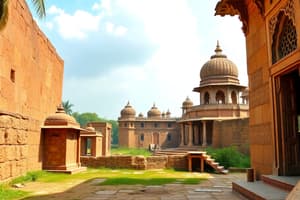Podcast
Questions and Answers
What were the main sources of sustenance for tribal societies in India?
What were the main sources of sustenance for tribal societies in India?
Hunting, fishing, gathering, and agriculture
Describe the social structure of tribal societies.
Describe the social structure of tribal societies.
Clans, families, and kinship
What beliefs were common among tribal societies in relation to the spirit world?
What beliefs were common among tribal societies in relation to the spirit world?
Animism, reverence for nature spirits, and ancestor worship
Who were referred to as 'dikus' in medieval India?
Who were referred to as 'dikus' in medieval India?
What is the caste system and how did it impact tribal societies and dikus differently?
What is the caste system and how did it impact tribal societies and dikus differently?
Explain the term 'dikus' and its significance in Indian history.
Explain the term 'dikus' and its significance in Indian history.
How did tribal societies and dikus interact historically, and what were the main reasons for their conflicts?
How did tribal societies and dikus interact historically, and what were the main reasons for their conflicts?
Give an example of a historical alliance between tribal societies and dikus and explain its significance.
Give an example of a historical alliance between tribal societies and dikus and explain its significance.
How does the NCERT Class 8 History textbook contribute to students' understanding of tribal societies and dikus?
How does the NCERT Class 8 History textbook contribute to students' understanding of tribal societies and dikus?
Why is it important for students to learn about tribal societies and dikus in the context of Indian history?
Why is it important for students to learn about tribal societies and dikus in the context of Indian history?
Flashcards are hidden until you start studying
Study Notes
Exploring Class 8 NCERT History: Tribal Societies and Dikus
Historical knowledge is a fascinating exploration of civilizations, their origins, and the fascinating complexity of human interactions. In this article, we'll delve into Class 8 NCERT History, focusing on the subtopics of tribal societies and the term "dikus."
Tribal Societies
Tribal societies were groups of people who lived together, sharing a common culture, language, and traditions. In India, these communities were often located in the hinterlands and remote regions. They relied on hunting, fishing, gathering, and agriculture for their sustenance. The history of India is replete with a multitude of tribal communities such as the Santhals, Gonds, Oraons, and Bhils, among others.
Tribal societies followed a social structure that revolved around clans, families, and kinship. Their beliefs were intrinsically linked to nature and the spirit world. The tribal people often practiced animism, with a reverence for nature spirits and ancestor worship. They also had a rich oral tradition, with stories, legends, and historical accounts passed down from one generation to another.
Dikus
The term "dikus" was often used in medieval India to refer to non-tribal people, especially those hailing from the neighboring civilizations like the Jats, Rajputs, and Brahmins. These groups typically followed a caste system, which divided people into hierarchical categories based on their occupation, social status, and religious background. In contrast, tribal societies rarely practiced the caste system.
The term "dikus" could also refer to non-Hindu religious groups, such as Buddhists, Jains, Muslims, and Christians. While tribal societies often practiced animism, the dikus followed different religions depending on their heritage. The word "dikus" is derived from the Sanskrit word "diksita," which means "initiate."
Tribal Societies and Dikus: Interactions and Conflicts
Tribal societies and dikus often interacted, but their relationship was not always peaceful. In many instances, the tribes were exploited by the ruling classes, who used them as a source of labor, military conscripts, and tax revenue. The dikus also frequently raided tribal villages, stealing resources and enslaving the tribal populace.
However, there were also instances where tribal societies and dikus cooperated and formed alliances. These relationships were crucial for the tribes' survival, as they were able to gain protection, resources, and knowledge from the dikus. For example, the Santhals and the Rajputs formed an alliance to resist the British East India Company's colonial expansion.
What NCERT Class 8 History Shares
The NCERT Class 8 History textbook introduces students to the complex tapestry of Indian history. It covers various aspects of tribal societies, including their social structure, culture, and traditions. The textbook also introduces students to the concept of caste and the relationship between tribes and dikus.
The Class 8 History textbook encourages students to think critically and analyze historical events and their impact on Indian society. The textbook also helps students understand the importance of preserving tribal culture and promoting equity and justice for all communities.
Conclusion
Tribal societies and dikus are integral parts of India's rich history. Understanding their relationship and interactions is crucial for students to comprehend the nuances of Indian society and the complexities of human interaction. By exploring these subtopics, we can gain valuable insights into India's history and promote a deeper understanding of its cultural and social heritage.
Studying That Suits You
Use AI to generate personalized quizzes and flashcards to suit your learning preferences.




